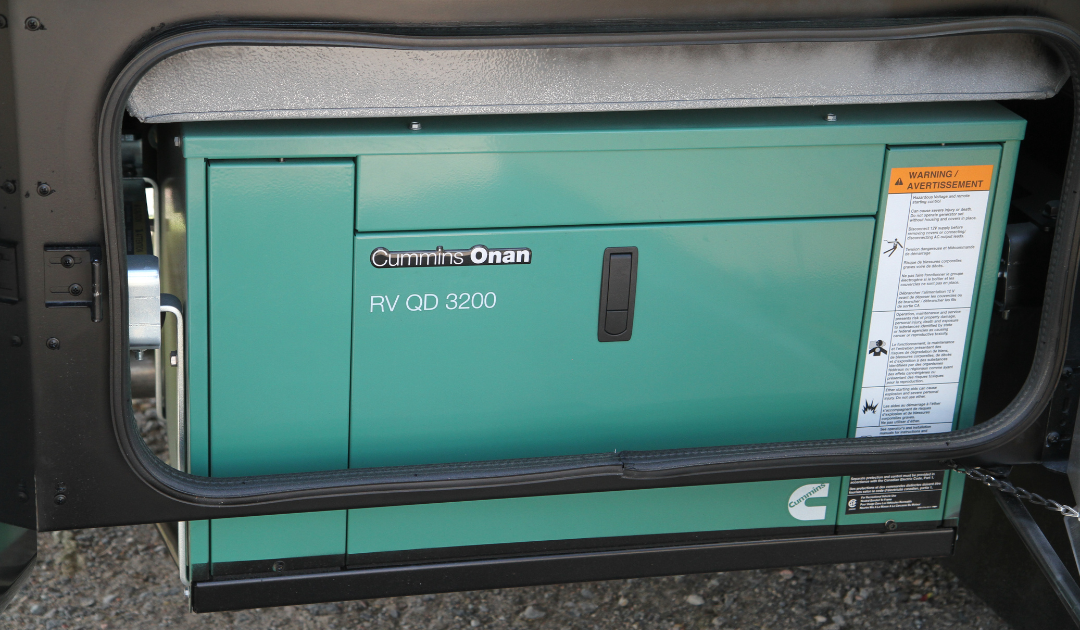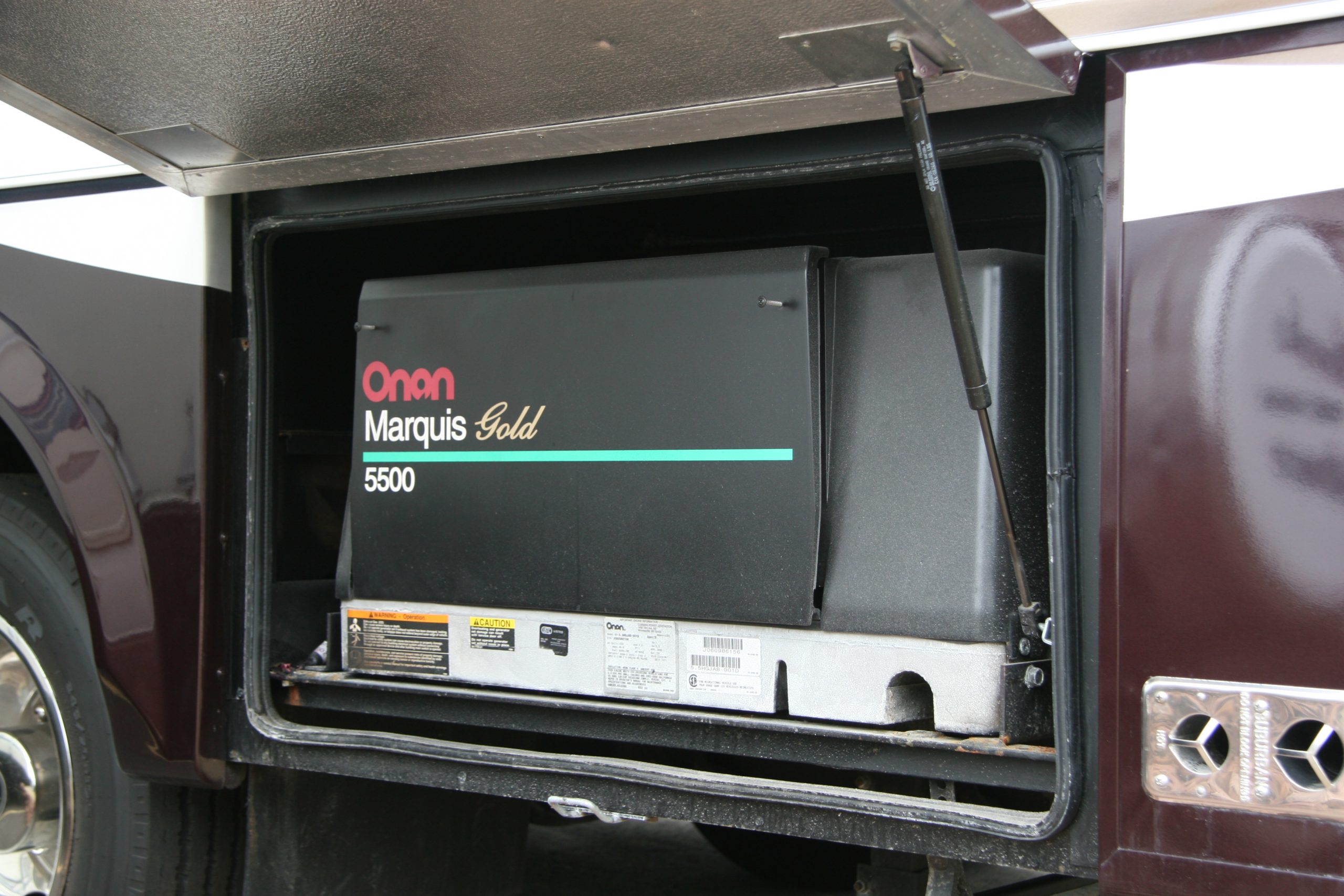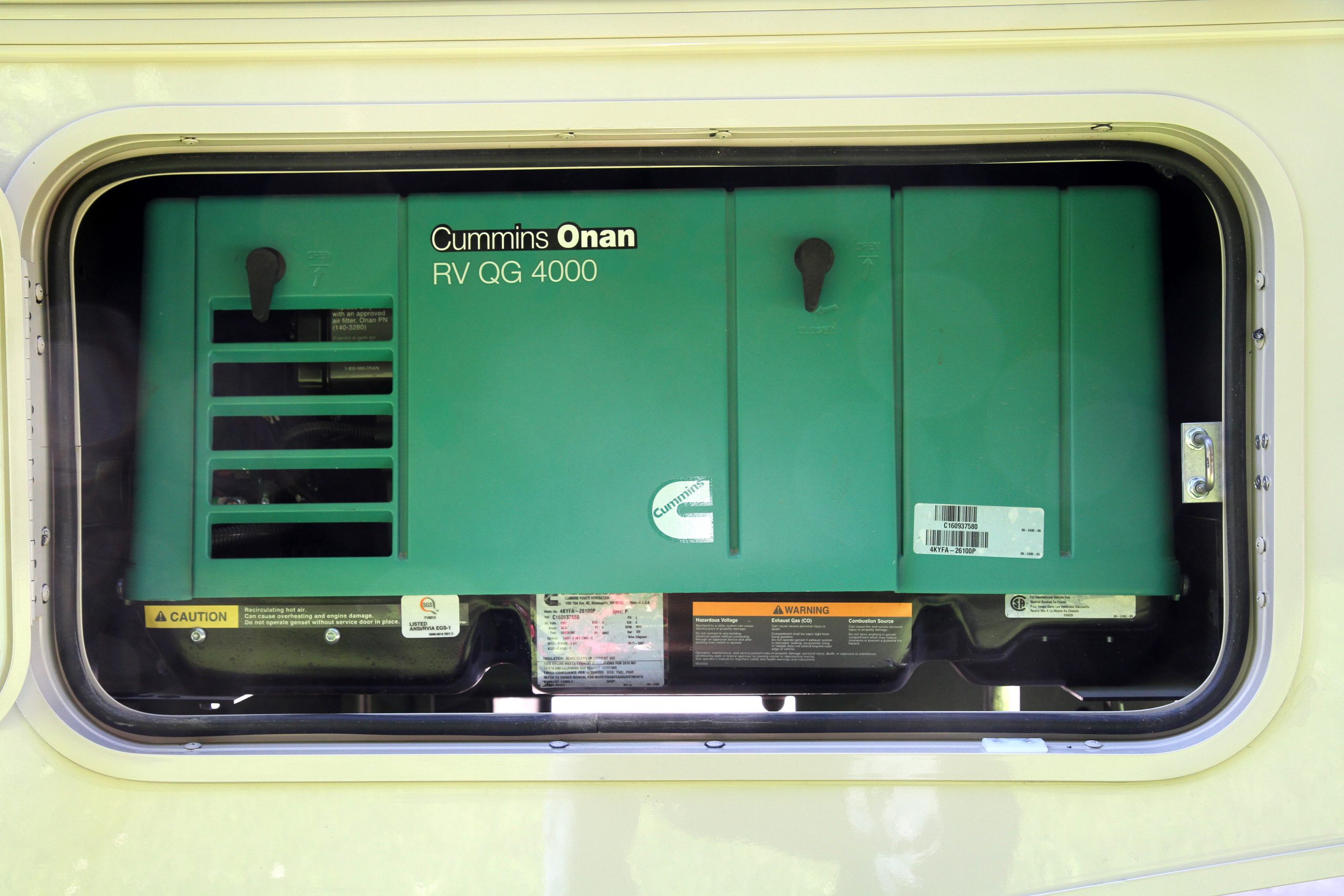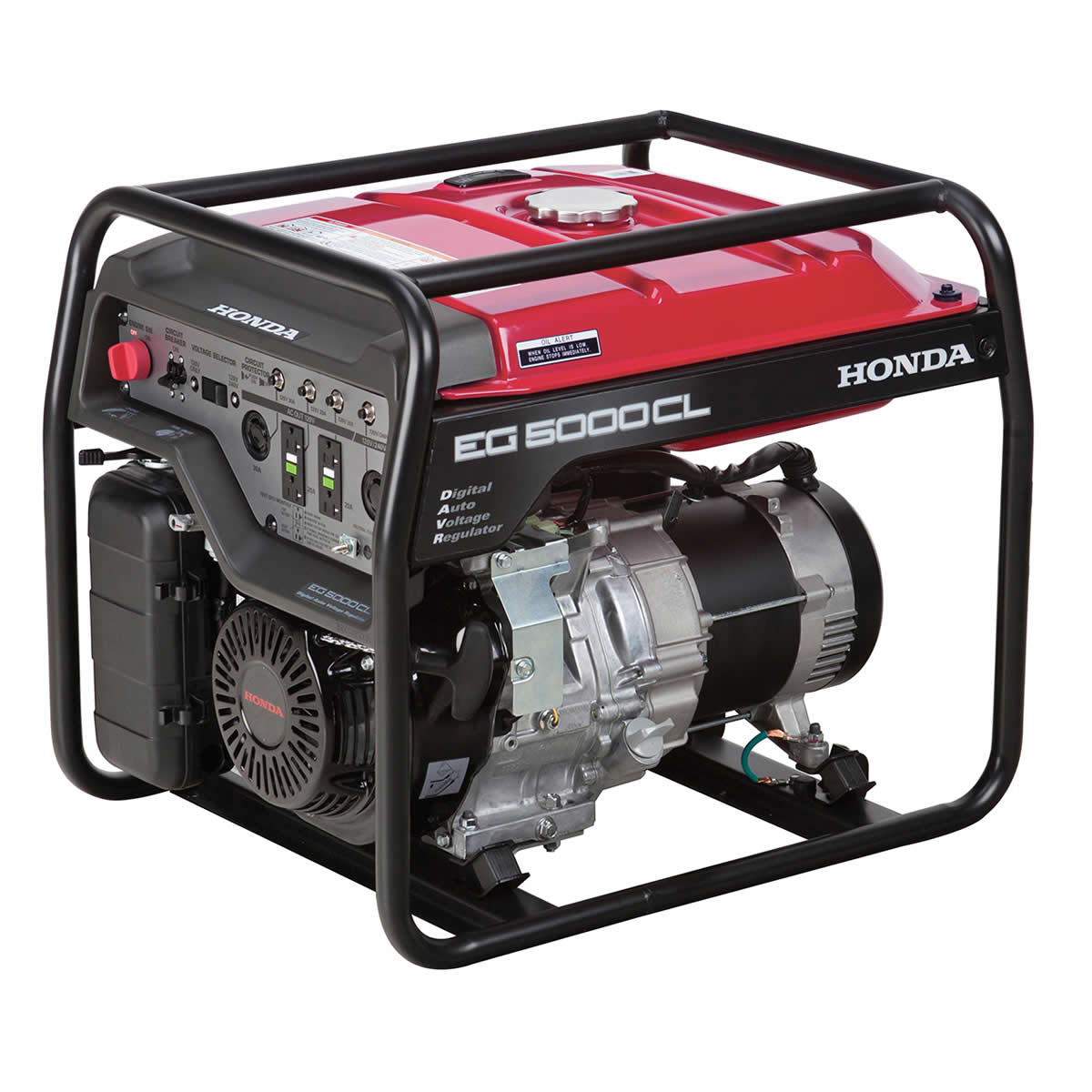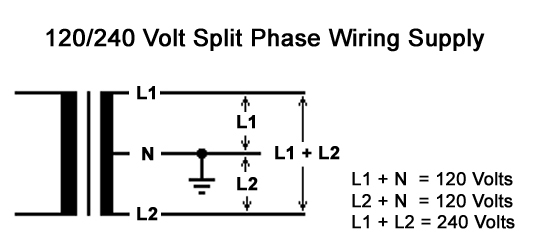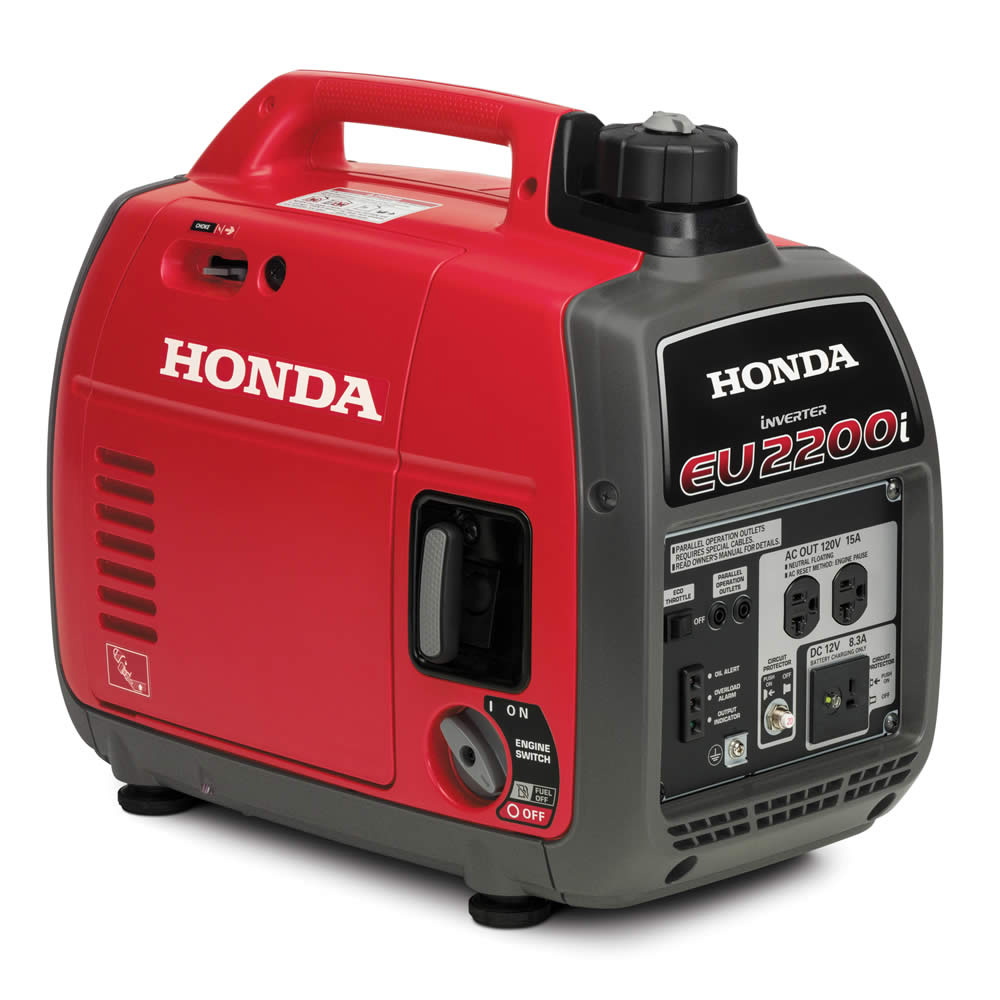RV Generators: A How-To Guide
Modern motorhomes are packed with the latest technology and household conveniences. Items such as washer/dryer laundry centers, dishwashers, entertainment systems featuring multiple HD TVs, residential refrigerators and electric cooktops all require 120 volt AC power – and that’s in addition to the rooftop air conditioners.
All of these items operate just fine when you are parked and plugged into a campground pedestal that supplies shore power to the coach, but what happens when you are driving or camping at a location that does not have any shore power?
Many coaches have inverters that will power some devices, such as a residential refrigerator, microwave oven and entertainment systems. But larger AC power loads can’t be handled by an inverter when driving, such as rooftop air conditioners. Plus, dry camping inverters can draw down your battery bank pretty quickly, so you will need to rely on the motorhome’s generator to provide AC power in order to operate these items and to recharge your battery bank.
Generators come in various forms and sizes, so it’s best to analyze what your power consumption needs and particular applications are when choosing the best generator for you. First, let’s understand a bit how generators work…
Portable- Versus Permanently-Mounted RV Generators
Most larger Class A coaches will come equipped with a generator that is permanently installed in the coach. Larger diesel pushers generally have them installed in the nose of the coach and are mounted on a slide-out rail for ease of service. Gasoline powered motorhomes that are of a front engine design will have them installed in a side compartment, or may even be an optional feature.
Generators such as this 5500 watt Onan Marquis Gold gasoline powered generator are commonly mounted in a basement compartment on gas powered class A motorhomes.
Installed generators have the benefit of using the same fuel tank that feeds the engine. The output wiring is connected to an automatic transfer switch, making it a simple task to start the generator via a switch in the motorhome’s interior. Smaller Class C and Class B motorhomes are limited on storage, so a generator is often an option not chosen by the buyer, opting instead for more storage space. In that case, a portable generator might be a better choice.
Compact units – such as this 4,000 watt gasoline powered Onan – are typically installed in Class C or B+ coaches where basement cargo space is limited in height.
Portable generators won’t tie up your RV’s basement storage space, but you will have to find some place to carry it, like in the back of a pickup bed. They can multitask, so you can use the generator in other locations without the RV. You can even use it to provide emergency power during an outage at your home. One drawback is that you need to carry a separate fuel supply for the generator, which also requires storage. Weight is also a consideration because the need for horsepower increases as the wattage demand goes up. More horsepower means larger engines that are heavier, making the generator harder to handle.
Units such as this Honda 5,000 watt are portable and can be moved by two persons.
Frequency
Household power in North America is 60 Hertz – which is the measurement of the power’s frequency or wavelength per second – while electrical power in Europe is 50 Hz. Any electrical device designed for use in North America will require 60 Hz power in order to operate. Frequency in a generator is determined by the number of times a magnetic field passes by a generator’s stator winding and receives an induced charge. In a generator with two field coils, the generator needs to spin at a constant 3,600 RPM in order to create 60 Hz power while a generator with four field coils only needs to run at 1,800 RPM.
Most portable generators are of the two pole design to save weight on both the engine and the generator itself. For example – a 3,500 watt generator will require around 8 HP to generate that much electrical power. A typical 8 HP engine will produce that power at peak RPM, which is going to be close to the 3,600 RPM that a two pole generator will operate at. A four pole generator will only need to turn at 1,800 RPM to achieve 60 Hz, but a four pole generator is heavier and bulkier and the engine won’t be able to create its maximum rated power at that slower speed. Therefore, a large engine rated in the 12-14 HP range at 3,600 RPM will need to be used so that 8 HP is still available at the lower 1,800 RPM. The extra weight and size of the larger engine and generator doesn’t make it a good choice for a portable generator but is best suited for a stationary mount where the quieter operation associated with lower RPMs is beneficial.
Split Phase Versus In-Phase:
Regardless of whether your generator is a two pole or four pole unit, there will be two field windings that provide power to the receptacles. Each winding is capable of producing 120 volts of AC power at one half of the rated capacity of the generator. These windings can be connected in series to offer 120 or 240 volts in a split phase design, or in parallel to offer only 120 volts in what is referred to as an in-phase design. For example – a 6,000 watt generator has two field coils, each with 3,000 watts of available power at 120 volts. Referring to the graphic below, we can see that there are 6,000 watts of 240 volt power available between L1 and L2. There are 3,000 watts of 120 volt power available between L1 and Neutral, and another 3,000 available between L2 and neutral. 3,000 watts at 120 volts is only 25 amps. Unfortunately, you can’t draw 30 amps on one circuit because the two fields are in series.
The graphic referred to in the text as the Split Phase diagram
The split phase system works fine on larger generators, such as 10,000 watts and up, but has its limitations on smaller units. Many of the smaller units used in RVs do not have 240 volt capabilities, which is fine because 240 volt appliances in an RV are extremely rare except for very high end coaches. In this case, the two windings are placed in parallel rather than series. This eliminates any 240 volt capability but allows for the full 6,000 watts to be available on any one circuit. This is referred to as an in-phase system and is generally used on generators rated at 7,000 watts or less.
Inverter Generators
Inverters are the opposite of converters. A converter takes 120 volt AC power and converts it to 12 volt DC power to operate lights, water pumps, fans and other 12 volt accessories in the RV as well as battery charging power. An inverter takes 12 volt DC power from the batteries and inverts it to create 120 volt AC power. Small inverters can be used to power an entertainment system while larger inverters can power a number of receptacles and appliances. This means you don’t have to run your generator to keep a residential refrigerator cold while driving and can also operate a microwave and a few outlets. They are helpful because it extends the time interval between times when you need to run the generator to recharge batteries or run larger loads.
An inverter based Honda 2200 watt unit.
However, inverter technology has also filtered into generators as well. Inverter based generators are popular in some of the small portables, such as the Honda EU2200 series as well as in the Onan Quiet Diesels in the 7KW to 8KW range. In a sense, these generators are not true AC generators, although their eventual output is AC power. They are actually DC generators that send their variable DC output through inverter circuitry built into the generator itself. This eliminates the requirement to operate at a steady 1,800 or 3,600 RPM because the inverter electronics convert the DC power from the generator into 120 volt AC power and establish a 60 Hz frequency electronically.
A DC generator has no requirement to turn at any given speed because the output power increases as the generator’s speed increases. This allows the generator to operate at a lower RPM under light loads, saving fuel and reducing the noise level.
As you add more demand for power, such as when an air conditioner starts up, the generator’s speed will increase to raise the power output level, all the while maintaining a steady 120 volt AC power level at a 60 Hz frequency. Inverter based generators also put out fairly clean power with low levels of noise or total harmonic distortion (THD), which is a benefit when powering sensitive electronic equipment. Inverter generators are not found in the larger 10KW sizes and up because the inverter boards would be large and expensive and generally not necessary with the stability present in the larger diesel generators. However, they are quite popular in the smaller portable models.
Sizing
When selecting the proper size generator, it’s important to remember that wattage is the measurement of true power. A 50 amp shore power supplies 50 amps of 120 VAC power on each leg. “Amps” x “volts” = watts, so a 50 amp shore power receptacle is capable of providing 6,000 watts power on each leg, for a total of 12,000 watts. Therefore, if you want a generator that can match that power, you’ll need a 12,000 watt generator. If you don’t use all of that power, you may be able to step down to a 10,000 watt generator, but the biggest factor is with air conditioning. A coach with two rooftop air conditioners may be able to get by with a 7,000 watt generator, depending on how many other 120 volt accessories you have. But any coach with three rooftop units is going to need at least 10,000 watts.
When sizing up a generator, you need to consider how your loads are distributed across the breaker panel. A split phase generator can only supply half of the total capacity on each leg, so you have to be sure that your heavy loads are evenly distributed across both legs of the panel. Remember that each leg has a given amount of amperage and on a split phase generator, they cannot be shared. If your loads are imbalanced, you’ll need a much larger generator just to feed one leg while the other leg is not being fully utilized.
Another consideration is static versus dynamic loads. Lighting and heating elements are static loads in that they always consume the same amount of amps. Dynamic loads are associated with components that have load requirements that vary under different conditions.
Motors are considered dynamic loads because the current draw varies according to how hard they are working – plus, they generally have a startup surge which can be up to three times the running load. Consider the case of an air conditioner. It may have a typical unloaded draw of less than 10 amps, but when it first starts up it will have a surge of in excess of 20 amps as the capacitor start motor starts up against the head pressure in the refrigerant. If the unit was resting long enough, it may settle in to around 10 amps immediately after startup but as the head pressure increases and the unit works hard, it can draw 12-14 amps. Consider that you most likely won’t be starting all three air conditioners at the same time so you don’t need to use the peak starting surge for every unit when calculating how large your generator needs to be. Remember that “volts” x “amps” = watts, so just multiply your amps by 120 to convert to watts in order to determine how many watts you’ll need.
Following are some examples of typical load requirements:
| Air Conditioners | 1400-2000 watts |
| Refrigerator | 600-1000 watts |
| Electric Frying Pan | 1000-1500 watts |
| Electric Stove Element | 675-1000 watts |
| Electric Water Heater | 1250 watts |
| Hair Dryer | 500-1500 watts |
| CRT Television | 200-600 watts |
| LED Television | 100-375 watts |
| Portable Ceramic Heater | 750-1500 watts |
| Toaster | 1000 watts |
| Satellite Dish and Receiver | 200 watts |
| Battery Charger/Converter | 750-1400 watts |
When sizing your generator, you also need to consider the fact that altitude affects the engine’s ability to create power. Different engines react in varying amounts. An Onan Marquis Gold series of gasoline powered generators will lose 3.5% of power for every 1,000-foot gain of altitude over 3,000 feet. The Onan Quiet Power Diesel 10,000 watt will derate 3.5% for every 1,000’ over 500’ of altitude and it further derates by 1% for every 10oF of temperature increase over 85oF. This equates to a 7,500 watt generator running at 9,000’ of altitude that will only be capable of handling 5,000 watts at that altitude unless the engine has enough excess horsepower to allow for it.
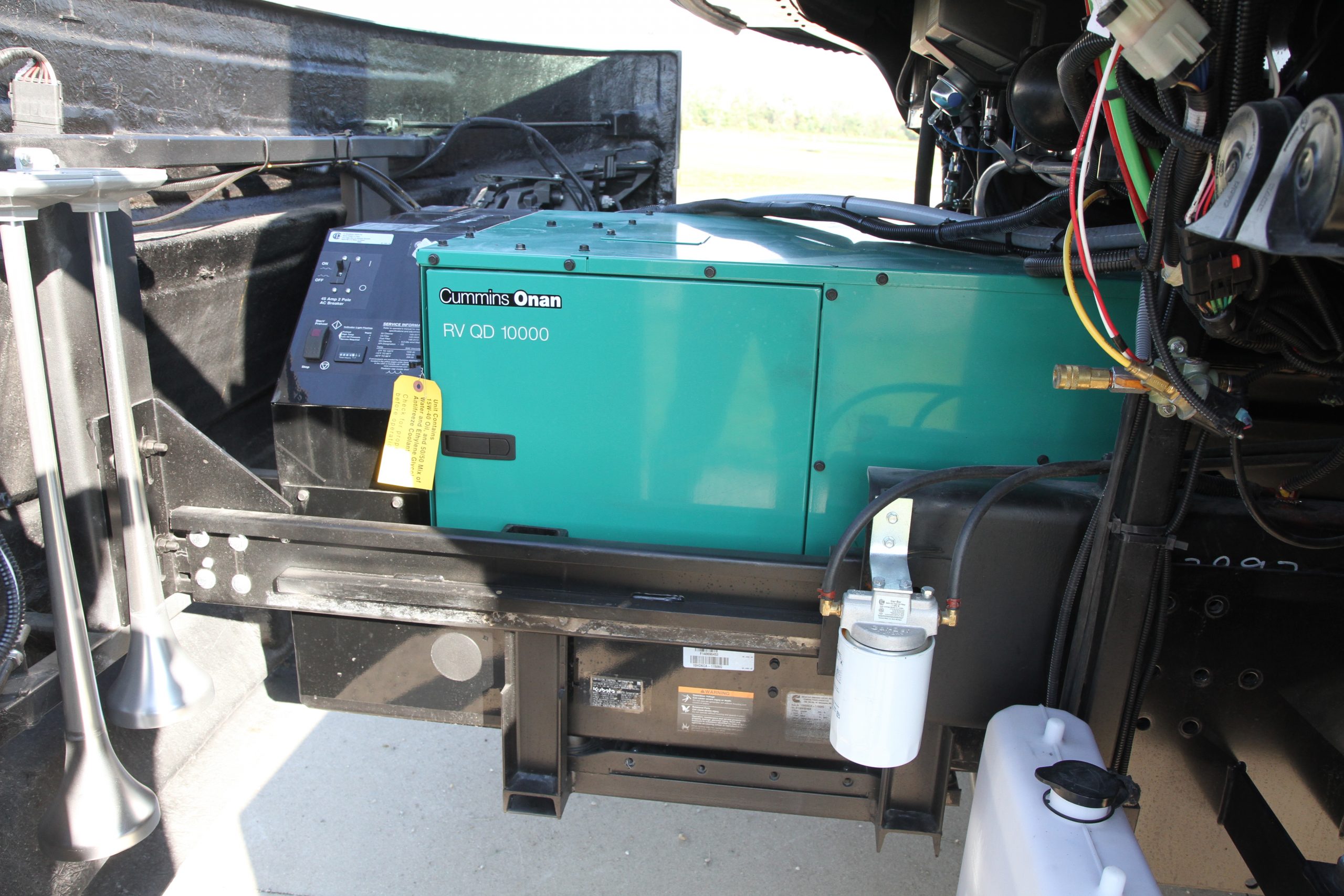
Most Class A diesel pushers have diesel powered generators, such as this Onan 10,000 watt installed in the front cap area of a Newmar London Aire are placed on slide-out rails for ease in service access.
Diesel engines are pretty much capable of handling the fuel injection requirement at higher altitudes but carbureted gasoline powered engines will have issues with running rich due to lack of air. Some generators, like the Onan Marquis Gold series, have a mixture adjustment on their carburetors. You can adjust the fuel flow with a lever to lean the engine out when operating at higher altitudes. But be sure to reset it to the full rich position when you return to the flatlands or else you run the risk of burning valves by running the engine too lean.
Armed with this information, you should be ready to select the best generator for your RV lifestyle. Be sure to include your generator when you have your RV tech perform scheduled maintenance on your motorhome. Taking care of it will ensure it will take care of you when you need it.

